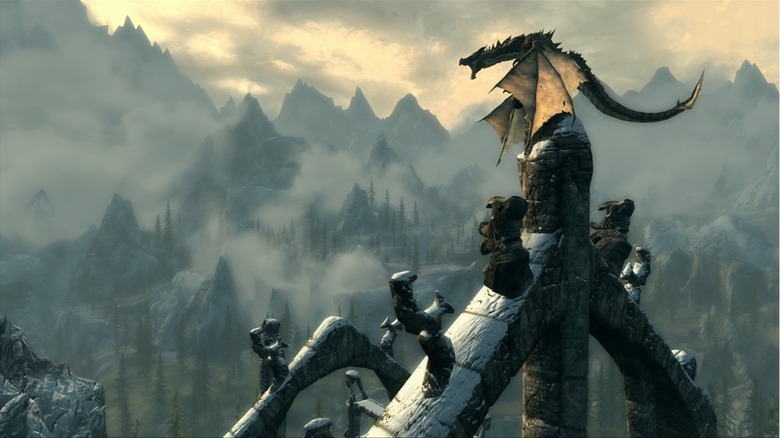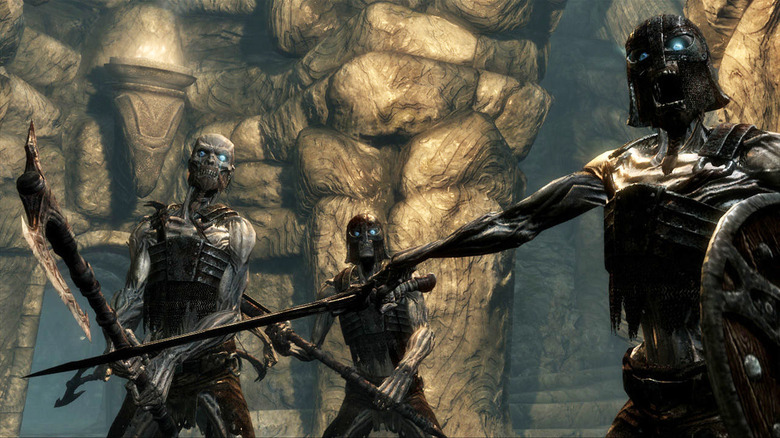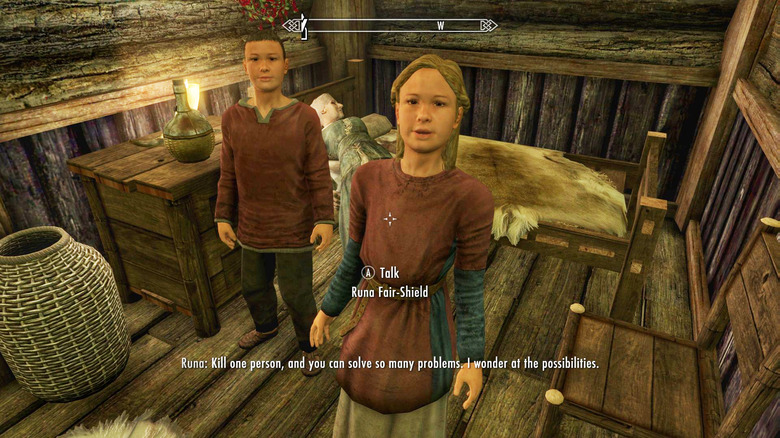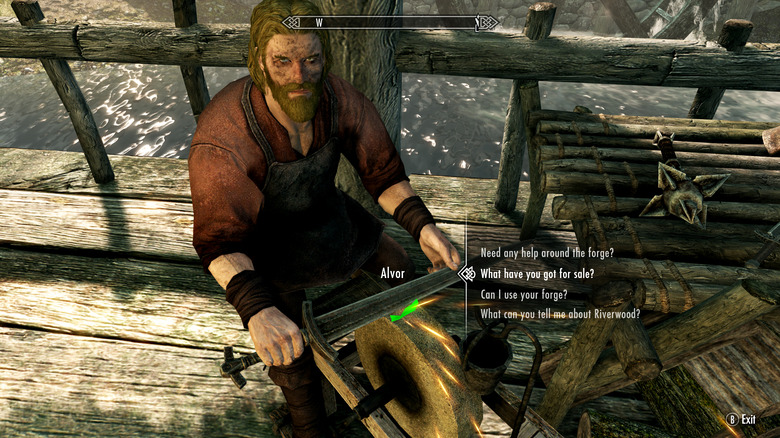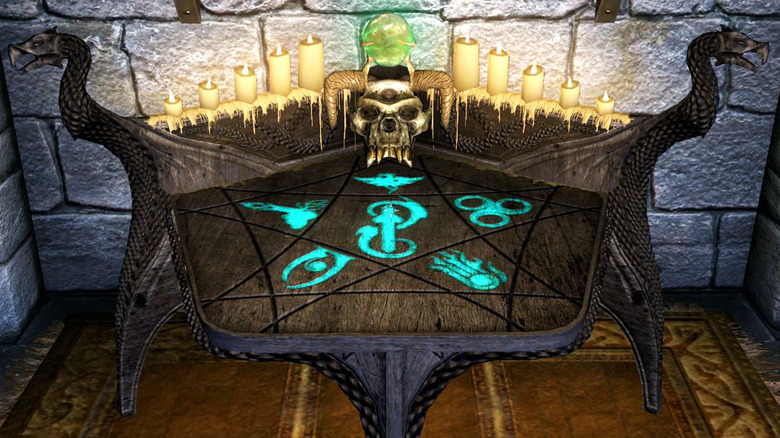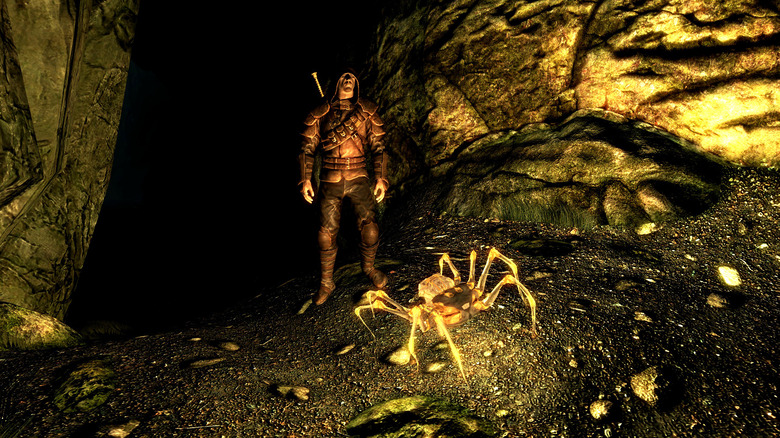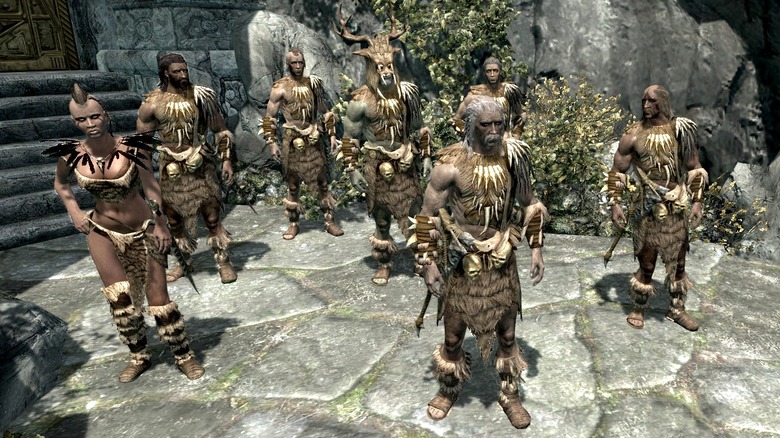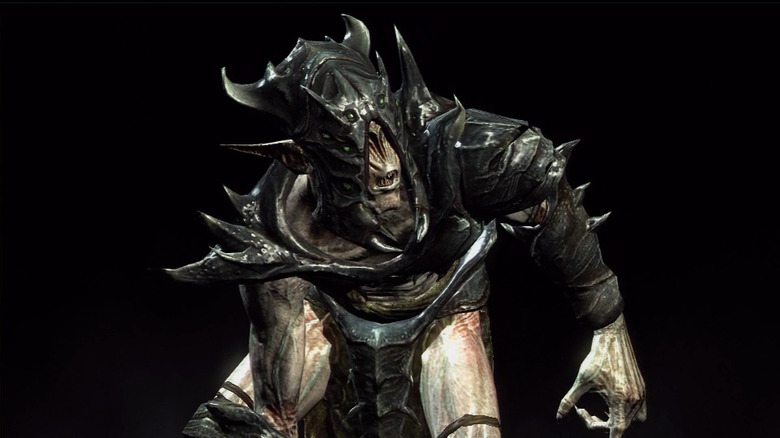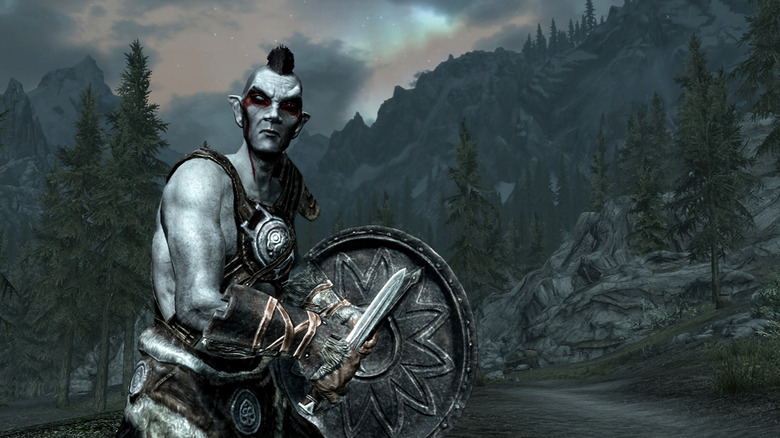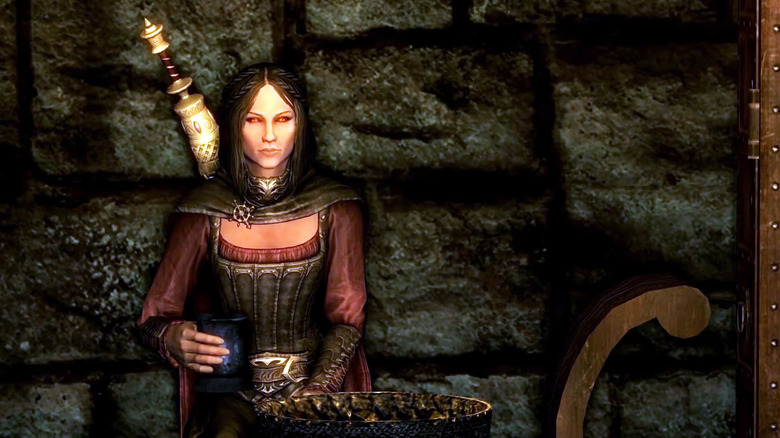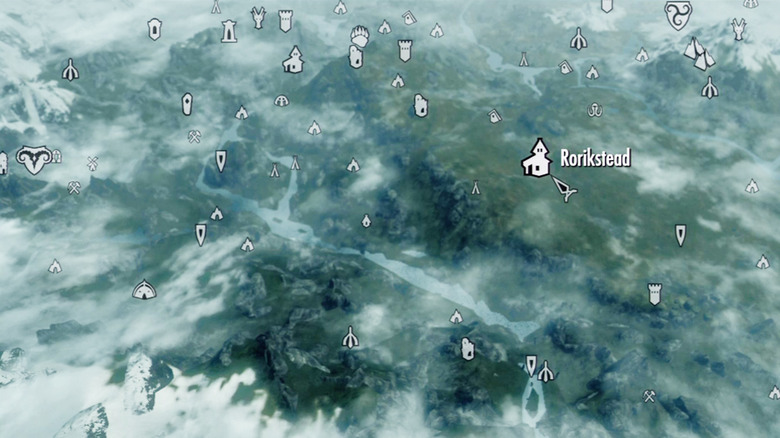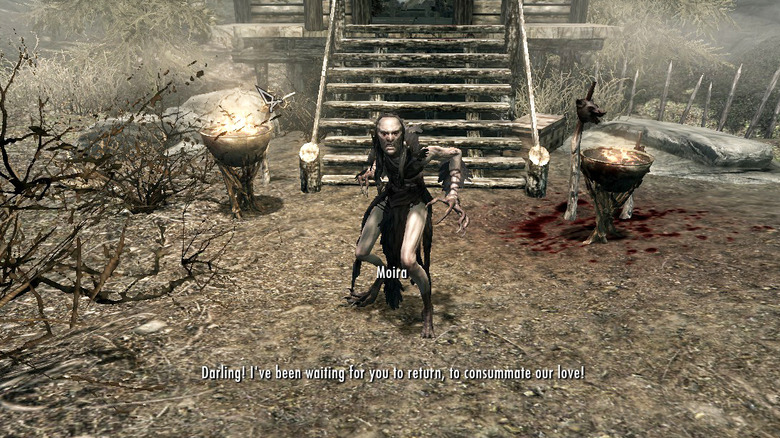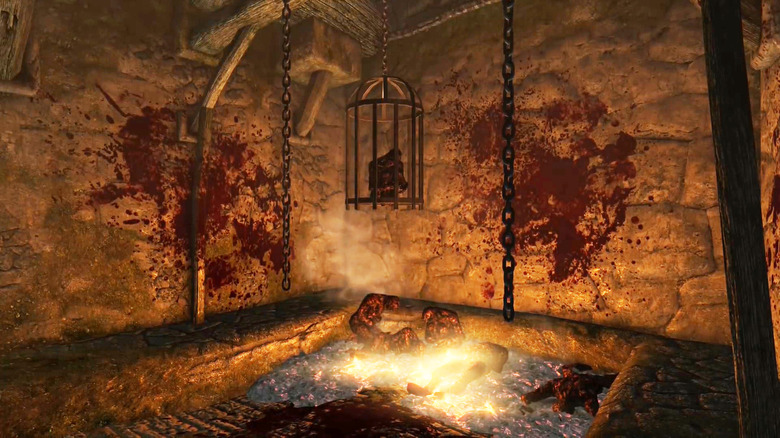Messed Up Things In Skyrim Nobody Talks About
With countless ports over multiple console generations, The Elder Scrolls 5: Skyrim from Bethesda Game Studios has become one of the most played video games in modern history. Collectively, we've spent a lot of time in Tamriel's northern continent; but despite all of this exploration, there exist a few narrative corners that remain hidden from the prying eyes of players hungry for pop culture references and Bethesda's trademark scattering of Easter eggs. The world of Skyrim is robust, but a great deal of lore lurks beneath the surface of this tale of Stormcloak rebellion and the rise of the last Dragonborn. As Game Director Todd Howard puts it: "Don't define your game by a list of features. Define it by the experience you want the player to have." It's clear that the devs at Bethesda wanted us as players to unravel many of Skyrim's mysteries for ourselves.
Even before the introduction of DLC like Dawnguard and Dragonborn, the holds of Skyrim offer some subtly strange and unusual narratives for those willing to take the time to look. The more secret the story, the more harrowing its truths; and sometimes the strangest stories are hidden in plain sight. Watch the skies, travelers: we're shining a light on a few of those messed up things in Skyrim nobody talks about.
The Dragonborn is a glorified grave robber
Skyrim is a land steeped in the traditions of the Nords, a tall and fair-haired people who are famous for their resistance to cold and their talent as warriors. The ancient tombs of their deceased are scattered across the continent and regularly serve as points of interest in the player's open-ended race against the dragon Alduin. These barrows, unified in form and function, are full of undead monstrosities, legions of traps, and lots of treasure. Enter the Dragonborn, who essentially becomes a glorified grave robber throughout the course of the game's epic narrative.
The familiar Jonesian phrase "It belongs in a museum" doesn't apply to the Dovahkiin, who begins rifling through the urns and ashes of the dead as early as the "Bleak Falls Barrow" main quest. Farengar Secret-Fire, the Court Wizard of Whiterun, challenges the Last Dragonborn to explore Bleak Falls Barrow and retrieve the Dragonstone. Along the way, you can plunder this ancient burial mound to your heart's content (and many players have). Similar Draugr barrows and other subterranean tombs are scattered liberally throughout Skyrim's enormous map, and part of the game's appeal lies in finding and exploring them; but rarely (if ever) does it discourage you from delving for wealth and wealth alone. Face it: the Dragonborn is a tomb raider.
You can weaponize children with illusion spells
Kids in Skyrim are invulnerable; and that can make for some rather messed up situations, especially when you throw some illusions into the mix. Despite their moralistic immunity to damage, the children of Skyrim are susceptible to other magic effects. From Alteration to Restoration (and everything in between), we all know the wonders of a well-placed and appropriately-timed spell — but casting illusion magic like Frenzy or Mayhem on children NPCs in crowded spaces can really wreak havoc (for better or worse). Mayhem, in particular, is a method of sure-fire success, considering the relatively lower levels of children NPCs throughout the game.
In case you missed it, Mayhem is a Master-level Illusion spell that causes creatures and people up to level 25 to attack anyone nearby for 60 seconds. Imagine, if you will, what happens when you cast such a powerful spell in a location like the Honorhall Orphanage in Riften, where Grelod "the Kind" metes out her own specific brand of toxic TLC. A half-dozen kids make short work of the old crone in such a tiny space. Meanwhile, there are children to be found in every major city and among many a tiny farmstead. Just imagine what it would be like if you had one of these diminutive unkillable dynamos a little closer to home. All of a sudden those adoption papers from the Hearthfire DLC are looking a lot more interesting.
You can sell merchants their own stuff
Believe it or not, you can actually sell the merchants of Skyrim the inventory from their very own shelves. And, no matter how you slice it, duping the locals like this just feels a little wrong. Whether or not you can pull this obliquely devious trick for fast (and painfully minor) profits depends on how friendly any given merchant NPC is to your character — a gameplay element guided by Skyrim's "Disposition" mechanic. Some merchants, like Alvor of Riverwood, will most likely be friendly to you when you very first meet them (Alvor becomes friendly after you complete the "Unbound" main quest and escape from Helgen). Others will have to be swayed by your silver tongue or the merits of your deeds.
Amusingly, these friendly vendors will allow you to loot the items on their own shelves before buying them back from you. And if you're not friendly enough with a merchant from completing a side quest or other such favor, you can look to the Investor perk to kickstart your profitable relationship. This Expert-level perk under the Speech constellation is the gift that keeps on giving, especially if you're trying to roleplay a more socially-proficient Dragonborn who likes to spend more time amongst civilization and less time looting the musty crypts and caves of Skyrim's outskirts.
The souls of slain creatures fuel commonplace magic items
The souls of the dead used as currency? Sad, but true. One of the most messed-up things going on in Skyrim isn't a dragon epidemic or the rash of stolen sweet roles: it's the ubiquity with which people from all walks of life barter and trade the souls of deceased creatures, stored in tiny stones.
Soul Trap is an Apprentice-level Conjuration spell that harnesses the living essence of slain creatures to store power in Soul Gems, which are used to create and recharge magical arms, armor, and other arcane curiosities. This form of magic is so commonplace, most vendors offer Soul Gems of various sizes for trade, and these arcane crystals often decorate the homes and lairs of Skyrim's most magically-inclined.
The history and origin of this pervasive occult practice is not fully understood, but scholars have identified the basics. According to the book, Souls, Black and White, "The nature of the soul is not knowable. Every wizard that has attempted it vanishes without a trace. What can be known is that souls are a source of mystic energy that can be harvested."
You can use spiders as weapons
The campaign against Alduin and his evil cronies brings us face-to-face with a lot of sinister threats, but also puts a lot of interesting tools in our kit for combat encounters. While the vanilla version of the game is pretty straightforward, additional content like Dawnguard and Dragonborn began to infuse Skyrim with decidedly stranger arms and armor for the fight against Alduin. The Dragonborn DLC, in particular, takes players to the far shores of Solstheim (where the strange flora and fauna of Morrowind have taken root), and explores some of the craziest narratives the game has to offer. It's here, in White Ridge Barrow, that you'll find one of Skyrim's most bizarre weapon sets: the Spider Scrolls, an assortment of enchanted, weaponized arachnids held in the palm of your hands.
Contrary to Skyrim's frostbite spiders, the albino spiders of Solstheim are smaller arachnids that populate areas including Fort Frostmoth, Fahlbtharz, Highpoint Tower, Kolbjorn Barrow, and the aforementioned White Ridge Barrow. The "Spider Experiment Notes" of the deceased Dunmer Servos Rendas and his sister Merilar reveal that Solstheim's albino spiders can actually harness magical effects via mechanics similar to an Atronach Forge. The crazy part: you actually wield the spiders using your scroll slots and toss them like grenades to deliver various magical effects. And just when you thought this DLC couldn't get any weirder ...
The bloody truth of the Forsworn struggle
The Stormcloak Rebellion isn't the only sociopolitical upheaval rocking Skyrim to its core: it seems the people of Markarth and the Reach have their own sordid story to tell, and some would rather let it go unspoken. If you've spent any time on the western edge of Skyrim's frontier, you've likely encountered the Forsworn, a relentless, savage-seeming people who wield primitive weapons and primordial magics with cunning and rage. "The Forsworn Conspiracy" side quest exposes the bloody and brutal truth behind the history of these displaced people. And it ain't pretty.
The Forsworn are a clan of native, druidic humans encountered in the Reach who were driven from their homeland during the Nord occupation of Markarth and its surrounding environs. They regard the southwestern-most hold of Skyrim as their ancestral homeland, and reject the Nord's occupation of the region as well as any "legal" authority the Empire has over it. The Forsworn briefly occupied Markarth, until the Stormcloaks were enlisted by the Empire to retake the city, resulting in the death of many Reachmen (aka Forsworn) during the battle to reclaim the walled Dwarven city. Since then, they've become boogeymen to (and often scapegoats for) the so-called civilized people who remain in their stead.
The Falmer were blinded by the distrustful Dwemer who took them in
The story of the Falmer is yet another woeful tale in the sordid history of Skyrim's troubled past, and it's pretty messed up. As it just so happens, Skyrim's long-extinct Snow Elves were blinded and imprisoned by the very hosts who gave them sanctuary as they fled their Nord aggressors. The twisted subterranean creatures known as Falmer are the result of this cruel and deceitful act, and serve as an enduring reminder of the saga's existential overtones and themes of karmic justice. Prior to this revelation, the Falmer are can be seen as little more than monsters who hunt the depths of Skyrim's cavernous underground with keen ears and cruel hearts. But, like many good tales in Tamriel, their story takes a bit of puzzle solving to bring to life.
The events of this struggle are related in the epic poem "The Betrayed" by Engwe Emeloth, which is a book that can be found as part of the "Ancient Falmer Tomes" side quest: "Torn from their home of ice and frost. / Thrown into the pitch black dread of night. / Living in fear as their minds become lost. / As their eyes began dimming the light." It further explains the Snow Elves' subjugation at the hands of the Dwarves: "Chained and enslaved. / What once was light turned to blackness. / Alone and betrayed. / Sinking deeper into madness."
Racism is alive and well, especially in Windhelm
As much as they offer us beautifully realized fantasy sandboxes to explore, Bethesda Game Studios makes games that actually reflect the world we live in. As director Todd Howard told Gamasutra, "The tone of Skyrim involves a more rugged world, a more lived-in world, where magic is more low-fantasy," since the region "just seems like it would be a more violent place." And as we well know, the IRL violence taking right place here on Earth is usually perpetrated by our fellow man. It's not so different in Skyrim (if you ignore the magic and mythical creatures), where otherwise like-minded elves and humans have waged war against each other for centuries.
The Nords of Skyrim are a provincial people, and the Dunmer of Windhelm bear the brunt of this misguided, and often violent, aggression. Not only are the dark elves confined to the city's ghettos, they're met with constant disdain by the local bigots. As the carriage driver Alfarinn remarks of Windhelm, "It's not the friendliest for outsiders. The Dark Elves were all forced to live in the slum called the Gray Quarter. The Argonians can't even live in the walls. They're all stuck out on the docks. Still, Candlehearth Hall's got decent food and cheap bunks. You could do worse." Sadly, as inescapable as Windhelm's racism remains, it becomes all too easy for it to become a minor nuisance. Unless you're a Dark Elf, that is.
The real reason you can't marry the Vampire Lord's daughter
Dawnguard, the first official add-on for The Elder Scrolls 5, features an all new faction questline and new locations, along with key NPCs like Vampire Lord Harkon — who seeks to blot out the sun itself using the power of the Elder Scrolls — and his daughter Serana, an ancient pureblood vampire and potential follower. Serana is considered by many players to be an attractive partner for adventures through Skyrim; thanks to the design team and acclaimed voice actor Laura Bailey, the character is beguiling, beautiful, and brutal in a fight. But when it comes to companionship in the eyes of Mara, Serana is out of the game (in a cosmic sense), thanks to an elaborate and evil plot courtesy of the Daedric Prince Molag Bal.
The vampires of Tamriel are an accursed lot, and (according to passages from the "Opusculus Lamae Bal") they are the supernatural progeny of Molag Bal following his rape of a mortal woman. As the Opsusculus explains, "Bal profaned her body," whereupon "violated and comatose, Lamae was found by nomads." The ritual that Serana endured to become a vampire was akin to this original Blood Matron rite, and it has left her with a cold disposition towards the temple of Mara and marriage in general. Holy matrimony is simply not for her. After her experience with religion, this would-be companion is officially off-limits.
The Daedric roots of Rorikstead demand sacrifice
The tendrils of Daedric corruption run far and wide through the nine holds of Skyrim; but, occasionally, one story of malfeasance stands out from the rest because of what we don't know. Strange things are afoot in the Whiterun village of Rorikstead, where an old sorcerer trains a new generation of magic users to carry on the dark and primordial traditions of a clandestine Daedric Prince.
The riddle of Rorikstead's detestable legacy is a hard one to find, let alone decipher; but a few elements in particular can help players start to piece this puzzle together. First, it's important to note Rorikstead's tangential relationship to the Daedra-laden quests "A Night To Remember" and "Erik the Slayer." But a few other clues are particularly damning: a book titled Spirit of the Daedra, the presence of Soul Gems, rumors of dead mothers and fertile land, and (most importantly) a curious old Breton named Jouane Manette who schools two young girls in the ways of dark magic — elements which seem to suggest a tradition of ritualistic sacrifice and subsequent bounties of arcane prosperity. While the true nature of Rorikstead's history remains a mystery, we're eager to find out more. But that's all part of the fun, isn't it? As Jouane puts it to his pupils, "Do you want the entire village to learn our secrets?" When it comes to some Daedra Princes, covertness is next to godliness.
That time the Dragonborn almost slept with a hagraven
One of Skyrim's most popular adventures is the raucous Daedric quest "A Night to Remember", which pays homage to the jocular late-night comedy The Hangover from Todd Phillips & Co. But one detail players often forget is that this fabled mission of ribaldry and drunken romance actually managed to put our hero in one of the more detestable situations of his storied career. In case you missed it: the Dragonborn almost shacked up with a hagraven.
The titular night begins with a conversation at the Bannered Mare in Whiterun, where (once you've reached Level 14) an ebon-cloaked conjurer named Sam Guevenne challenges you to an innocent drinking contest. "A few drinks, a few laughs, and a contest. What could be better?" As luck would have it, this is all a confabulation of Sanguine, the Daedric Prince of Debauchery, who leads you on a wild, booze-filled ride from one hold to another over the course of an evening you most certainly forgot. As the Dragonborn pieces together the missing moments of this alcohol-fueled escapade, you'll come to the startling realization that the Dovahkiin almost shagged Moira the Hagraven, your (gulp!) fiancé who's been waiting to consummate your love upon your return. Which begs the question: what do you call a "shotgun wedding" in Skyrim?
Morvunskar sits atop a torture porn dungeon
Whether you go there during the Daedric quest "A Night to Remember" or of your own accord, the fort southwest of Windhelm known as Morvunskar is rife with conjurers who possess rather questionable erotic appetites. And deep beneath its battlements lurks a dungeon of extremely perverse pleasures waiting to be explored. Two of Morvunskar's chambers raise a peculiar kind of suspicion: the torture chamber of the Altmeri necromancer, Naris the Wicked, and one strangely decorated bedroom chamber ...
If you know what to look for, this odd room's furnishings offer a few damnable suggestions about what goes on behind closed doors. The curious arrangement of three bed rolls, a shrine to the Aedric Divine of eroticism, a bottle of wine, and a handful of leather strips all seem to suggest a certain amplitude of sexual kink; and a nearby potion of invisibility takes the power of suggestion to a whole new level. Meanwhile, Naris can be heard muttering all manner of messed up phrases in his private torture chamber; between his musings on "The sweet smell of burnt flesh" and reflecting to himself that "They die too quickly. Maybe I'll try and hold off on the paralysis next time," we're ready to just burn this morbidly salacious creephole to the ground, take a cold shower, and let the next Dragonborn clean up the mess.

